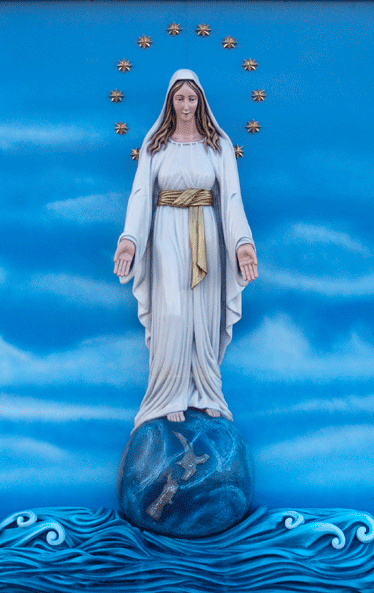Kieran Fenn fms
Kieran Fenn fms
The law of prayer is the law of belief’ is a saying that owes much to Augustine and the theological battles of the fifth century. It implies that the basis of doctrines can be seen in popular consensus as shown in liturgical celebration, of feasts in honour of Mary.
The dogma of the Assumption
Pius XII appealed to this consensus in 1950’s Munificentissimus Deus (Defining the Dogma of the Assumption):
‘By the authority of Our Lord Jesus Christ, of the blessed Apostles Peter and Paul, and by our own, we proclaim and define it to be a dogma revealed by God, that the immaculate Mother of God, Mary Ever-Virgin, when the course of her earthly life was finished, was taken up body and soul into the glory of heaven.’
There are no details about her death. The dogma simply says that Mary completed salvation, sharing in the fullness of the resurrection which God promised all peoples when God raised Jesus from the dead.
Vatican II emphasized the unity of Mary’s bodily and spiritual glory in heaven. The Assumption is of ‘body and soul’: the whole person will be saved. At death, every person receives a transformed body (not the corpse left behind) and is taken entirely into eternal life, since the soul cannot be separated from the body. Mary was sinless, yet she was not exempt from the final transformation in death.
A reference in Munificentissimus Deus to the Immaculate Conception lets two dogmas clarify one another: ‘Mary, immaculate Mother of God, always a virgin, after having completed the course of her earthly life…’
The text is interesting for what it does not say: how the Assumption took place, or whether Mary really died as her son did. The dogma says that Mary is already part of the new and definitive world of the resurrection. The power of Jesus’ resurrection sealed her earthly existence; Mary is called to, and is for us a sign of, full communion with God. Like her, we are called to the resurrection of body and soul.
From early on
Mary’s Assumption is not in the scriptures; but because of the early belief in Mary’s extraordinary holiness and her place in God’s plan, it was believed that she who was exceptional all through her life must have had an exceptional final destiny.
It took 500 years for the Assumption to take on a form free of the bizarre and legendary details in the apocryphal writings. In the East, from the sixth century, there was a feast of the Falling Asleep of the Mother of God which reached Rome in the middle of the seventh century.
The earliest discussion of Mary’s death is in the writings of Epiphanus (d 403), which say that either she died or did not. He does not know which. From the sixth century we read of the Assumption of Mary, rather than her ‘falling asleep’, in writings only translated after the dogma was defined
Bishop Theoteknos of Livias, in his Homily on the Assumption, says: ‘It was fitting that the most holy body of Mary, the God-bearing body, the receptacle of God, which was divinized, incorruptible, illumined by divine grace and full of glory … should be entrusted to the earth for a short while and be raised up in glory to heaven, with her soul pleasing to God.’
The Greek triad of virginity, grace and incorruption are connected. The East held the feast and the doctrine from early on; in the West, doubts were expressed by Jerome and Augustine.
Her place with us
Is the Assumption the final step in taking Mary away from us, after the Immaculate Conception showed how different she was from us? The Visitation gives a different picture. It is of two pregnant women, reaching out to touch the new life that is present in the rounding bellies of each.
It is too easy to place Mary in her Assumption beyond human reach, on her heavenly pedestal as Queen.
The Gospel readings won’t let that happen because they are about earth, pregnancy, labour pains, birth, life, death, and social transformation as the rich and powerful are pulled down from their thrones, the lowly are exalted, the hungry are fed, and the rich are sent empty away.
Mary’s place with God caused the Protestant psychologist Carl Jung to state that a woman had become the fourth member of the Trinity, raising the feminine to the level of the divine. I would rather see all humanity, women and men, raised with her to participate in the Godhead.
In the body of Mary, glorified, material creation begins to participate in the risen body of Christ. Mary’s Assumption anticipates not only the resurrected body of all Christians but the redeemed state of the whole cosmos which is at present subject to decay.
In Mary’s Assumption, what is material and beautiful on our earth, as well as what is authentically human, is promised immortality. Perhaps a more appropriate first reading for the Assumption than Rv 11:19a, 12:1-6 and 10a (which originally referred to the 12 tribes of Israel and a Church community based on the 12 apostles) would be Rv 21:1: ‘A new heaven and a new earth’.
Our place with her
In the middle of a century that saw the murder of six and a half million Jews, wars beyond nightmares, ecological destruction, the threat of nuclear annihilation, and the continued violation of what is feminine, the Church asserted that we find in a woman – Mary, Mother of God – the ultimate meaning of all reality.
Her body is sacred, as is the body of every woman and man on this earth. Her destiny is assumption, as is our destiny and that of our world.
Mary’s Assumption does not take her away from us. It places her right at the heart of our own journey. She is a reminder of where we are going. Her being proclaimed the greatness of the Lord; so does our own.